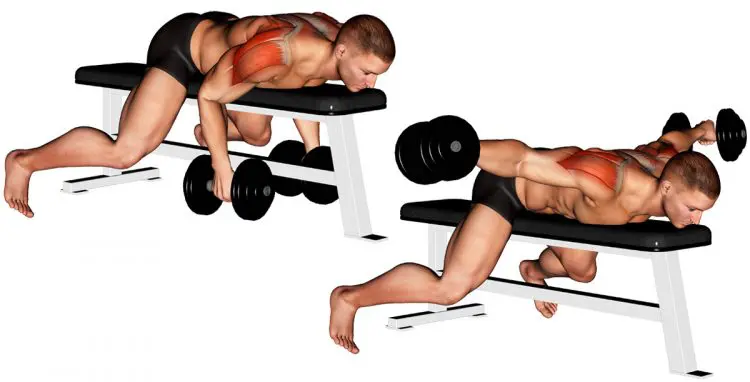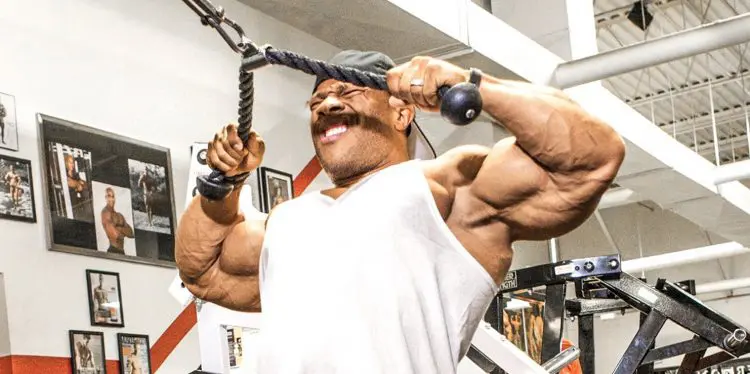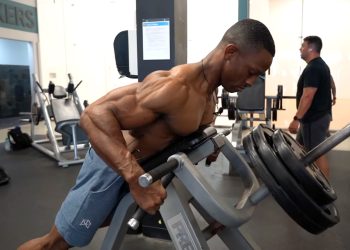Believe it or not, there are many who neglect to train a muscle if they can’t see it when they look in the mirror. They either think it’s not that important, they may forget, or think it gets worked enough during compound movements.
Well, you want to give attention to all muscles just the same but the rear delts are especially important because we tend to do lots of presses and you don’t want to have front-to-back muscle imbalances. The dumbbell lying rear lateral raise is a great exercise for isolating this muscle.
The rear delts are crucial for posture, proper lifting technique, and muscle symmetry… plenty of reason to never neglect them!
This exercise also works the lateral delts that give width and an overall very aesthetic look to the upper body.
Here’s a guide to this exercise with exercise instructions, tips, variations, and more.
In This Exercise:
- Target Muscle Group: Deltoid posterior
- Type: Hypertrophy, strength
- Mechanics: Isolation
- Equipment: Dumbbells
- Difficulty: Beginner
Muscles Worked
The dumbbell lying rear lateral raise works the posterior and lateral delts but there are other muscles involved too. Here’s a brief explanation of the function of each.
Level Up Your Fitness: Join our 💪 strong community in Fitness Volt Newsletter. Get daily inspiration, expert-backed workouts, nutrition tips, the latest in strength sports, and the support you need to reach your goals. Subscribe for free!

Deltoid posterior
Rear fly variations are programmed to build the posterior portion of the deltoids muscles. This movement mimics the natural action of the rear delts which is to move the arm outward and backward.
Deltoid Lateral
The lateral head between the anterior and posterior shoulder muscles rotates the arm laterally in the opposite direction of the body. It won’t get as much action compared to the rear delts but they’ll still benefit.
Infraspinatus
Attaching both to the top of the upper arm and shoulder blades, infraspinatus is the primary external rotator of the shoulder or glenohumeral joint.
Teres Minor
Another rotator cuff muscle, the teres minor lies below the infraspinatus and deep to the deltoid. It also contributes to arm movement and function at the shoulder joint. Rotator cuff muscles help with the stability and motion of this joint.
Trapezius Lower Fibers
If you draw a line from your lower back up to the neck you’ll hit the lower, middle and then upper trapezius because they’re separated into three sections of muscle fibers. The lower fibers act to depress the shoulder blades or bring them down.
Trapezius Middle Fibers
Moving up you’ll hit the middle trapezius fibers that change the function from depression to retraction of the shoulder blades.
Flys and pulling motions will activate all of the back muscles, although to varying degrees.
Related: 13 Ways to Avoid Shoulder Pain in The Gym
How To Do The Dumbbell Lying Rear Lateral Raise
Alright let’s go over how to do this exercise properly, after all, you are here to learn how to do it so that you can blow up those rear delts and get that 3D look.
Here are step-by-step instructions…
- Adust a bench to about a 30-degree incline or whatever allows you to lie flat and have enough room for your arms to move freely.
- Lie down so that your upper chest is on the bench and your head and neck are hanging off. Your shoulders should be aligned with the top of the bench.
- Grip the dumbbells and slightly bend your elbows.
- Raise your arms out to the sides and squeeze your shoulder blades together at the top.
- Lower your arms back down while fighting the resistance and repeat.
Here’s a great video example…
Make sure to include these 21 Best Shoulder Exercises For Big, Powerful Delts
Dumbbell lying rear lateral raise tips
- There’s no need to use max weights for this movement. You won’t be able to effectively lift them anyway in this position. Plus, this exercise is a good isolation movement and you cannot use momentum.
- You can keep the bench flat or adjust it to a comfortable incline angle. Although, you want to give your arms enough room to room and that’s why a slight incline can be more comfortable.
- You want to keep your chest on the bench at all times unless you’re more advanced and find that lifting up allows you to improve the contraction of the target muscle.
- Do not raise your arms out in front of you or too far back. Your arms should move in a comfortable direction relative to how you’re positioned.
- You can also do this exercise using one arm at a time.
4 Variations and Alternatives
There are a lot of great ways to train your rear delts but here are three similar variations that can work for you.
1. Seated rear delt raise
You can do these seated in a bent-over bent over position to work your rear delts. This is one of the most commonly used variations to pump up your deltoid posterior.
Again, you don’t need to use very heavy weights as you’re isolating and you want to be able to use a full range of motion in a controlled manner. Although, you still want to challenge yourself so make sure that it’s difficult!
2. Cable lying rear delt raise
Cables are an excellent training tool that we always recommend utilizing if you have access to them.
You can set up a bench between a cable machine and adjust the cable pulleys to a low position. Then, grab each side using the opposite arm and perform the exercise as you would the example above.
3. Barbell high row
Rows also work the rear delts but you can maximization their activation by pulling the weight toward your shoulders rather than your chest or stomach.
You can also use a fixed barbell that’ll allow you to use more weight and really benefit from the strength-building potential of this exercise.
4. Face pull
This one is more of an alternative but it’s also one of the best rear delt exercises that you can do. It has so many great benefits and one huge advantage of it over other exercises is that you don’t even need weights or any training equipment/tools.

You could actually stand in the doorway, place your feet out in front of you and the top part of your forearms against the doorframe. Then, you’d lean back and press your fists against the door to move your body forward.
Of course, this exercise is typically done using cables or bands too but whatever works best for you, just do it!
Also read: Best Rear Deltoid Exercises For Mass
How To Incorporate The Dumbbell Lying Rear Lateral Raise Into Your Training Routine
We recommend that every shoulder workout include an exercise (or two) that isolates the rear delts. For many, this muscle is very underdeveloped so make sure you match what you do for the front and lateral muscles.
The dumbbell lying rear lateral raise is a great choice and if your rear delts are lagging behind, do it before your other shoulder exercises.
A good example of a well-rounded shoulder workout would be to do a form of the shoulder press, lateral raise, rear delts movement, and face pulls or something similar.
This would ensure we train the back delts to build strength in the rear and balance out any potential imbalances you might be prone to from doing lots of presses and not enough pulls.
Of course, you may train your posterior muscles sufficiently and this would ideally not be an issue.
Sets/reps
We recommend at least 3-4 sets of anywhere from 8-15 reps. This ensures that you’re challenging yourself but not training too heavy or light.
Wrapping Up
The dumbbell lying rear lateral raise is a fantastic exercise for hammering your rear delts and ensuring you have well-rounded shoulder development. This exercise is beneficial for many reasons including improving your lifting performance and structural health.
Plus, there are lots of great variations or alternatives that you can do as well.
Interested in measuring your progress? Check out our strength standards for Face Pull, Shoulder Press, Dumbbell Lateral Raise.











